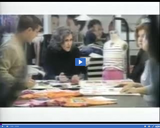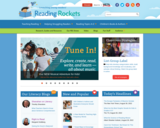
Chapters 4 and 5 specially address the terms and how understanding the terms can improve writing instruction.
- Subject:
- Professional Learning
- Material Type:
- Reading
- Provider:
- Utah State Board of Education
- Date Added:
- 06/08/2023

Chapters 4 and 5 specially address the terms and how understanding the terms can improve writing instruction.

This resource is a collection of ideas for classroom arrangement, management systems, and classroom libraries.

Provides an overview of research on reading engagement and motivation. Works as a brief and good introduction to this topic.

The Purple Coat, written by Amy Hest, illustrated by Amy Schwartz. Despite her mother's reminder that "navy blue is what you always get," Gabby begs her tailor grandfather to make her a beautiful purple coat. Viewers visit the Fashion Institute of Technology where they explore the fascinating world of design.

ReadingRockets.org provides free resources about teaching children to read and helping kids who struggle. You’ll find a hundreds of articles on teaching reading, classroom strategies, in-classroom video, parent tips in 11 languages, video interviews with top children’s book authors, a daily news service, and much more.

A brief overview of this topic (disciplinary literacy) including links to additional professional development and classroom resources.

Download, complete, and submit this form for Evidence of Preparation and Planning.

This page includes links to the varied Tiers of instruction and defines each one.

An excerpt from the online open access source Writing and Critical Thinking Through Literature, this chapter explores how to conduct a literary analysis of creative nonfiction.

In this Voices from the Middle article, Kristen Robbins draws on her middle-school teaching experiences to share with teachers some strategies for responding to student writing throughout the writing process rather than waiting until the end to give grades to student writing products.

In this Writers Who Care blog post, Kara Douma shares how a K-W-L strategy for student learning can be deepened by thinking of how to activate meaningful reflection. Teachers may find this resource useful as they consider how to deepen reflective practices in their own classrooms.

Provides some activities on teaching sentence fragments as intentional, rhetorically useful possibilities for writers.

This article reviews the book "Using Science Notebooks in Elementary Classrooms" by Michael Klentschy and provides basic information about the role of notebooks in instruction and assessment.

This article highlights science lessons about mammals, mammal diversity and adaptations, and polar mammals. Literacy integrations and alignment to national standards are included.

This article provides geography lessons to teach elementary students about the polar regions. Literacy extensions are included for each lesson.

In this issue of the free online magazine Beyond Penguins and Polar Bears, learn about the tools and technologies scientists use to study the land, ice, ocean, atmosphere, and living creatures of the polar regions. Students can also learn about the day-to-day life of a scientist working at the South Pole and plan their own research expedition.

This article details the purpose behind screening measures for reading difficulties in grades 4 - 12. It also discussed the tiered nature of response to intervention in addition to recommendations for improving Tier I instruction.

This article provides both a rationale for vocabulary instruction to build reading comprehension and some specific strategies for choosing and teaching vocabulary connected to reading. It has a specific section on teaching vocabulary with word parts.

This document provides a brief overview of adolescent literacy as a separate and distinct skill from childhood literacy and the importance of continuing literacy instruction into higher grades (4-12). This source also includes links to several important reports on adolescent literacy, e.g. Reading Next, Writing Next, etc.

This issue of the free online magazine, Beyond Penguins and Polar Bears, examines how elementary teachers can introduce the Arctic and Antarctica and use science, geography, literacy, and technology to help students compare and contrast these two dramatically different areas as well as their own home.